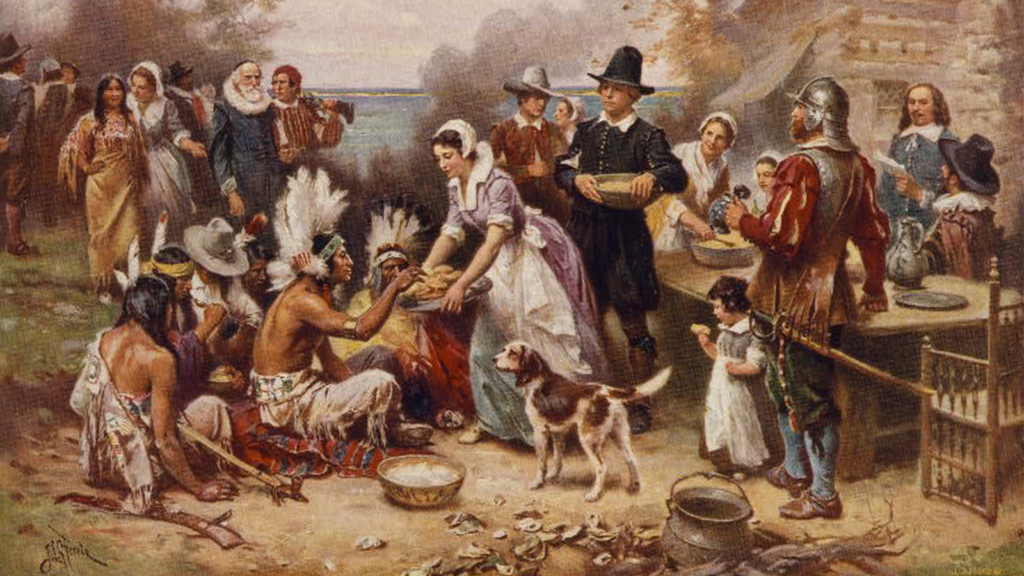Article courtesy and originally published by the Washington Tribes Newsletter
Generations of Americans have been erroneously taught that the “First Thanksgiving” in 1621 was a friendly celebration of the harvest season, shared between English colonists, known as Pilgrims, and Native Americans, unidentified by tribe, who had helped the Pilgrims survive. This story, which was created decades and centuries after the event took place, is filled with inaccuracies.
Here are some things you need to know to understand the real story of the First Thanksgiving. These questions and answers were compiled from several educational resources. We have listed the resources below and encourage readers to explore them.
Q: Who were the nameless “Native Americans” at the First Thanksgiving?
A: The area surrounding the location of the First Thanksgiving had been home to the Wampanoag people since time immemorial. Around 1600, there were approximately 40,000 Wampanoag, known as “People of the First Light.” They had been in contact with European explorers, traders and enslavers for nearly a century before the arrival of English colonists in 1620. Massasoit, also known as Ousamequin, intertribal chief of the Wampanoag Indians.
Q: Why did the Wampanoag help the English colonists?
A: The Wampanoag decided to help the settlers after months of careful observation and negotiations. This decision had less to do with friendship and more to do with political alliances against neighboring tribes. In the spring of 1621, Wampanoag Chief Massasoit, also called Ousamequin, signed a treaty of mutual protection with Governor John Carver. Some Wampanoag expressed concerns that the treaty, which was written in English, favored the English. Despite these concerns, the Wampanoag honored the treaty, teaching the colonists how to grow food and sharing their hunting, fishing, gathering areas and trade networks with the colonists. Once the misunderstanding was cleared up, the Wampanoag and the English shared food and company for three days.
The treaty of mutual protection, written in English, took advantage of the language and cultural differences between the two groups. (Photo credit: State Library of Massachusetts)
Q: Was there a shared “First Thanksgiving” meal?
A: Yes, though it wasn’t called that until centuries later and came about somewhat by chance. As told in the only account of a harvest celebration, written by English colonists several months after signing the treaty, the English decided to celebrate their first successful harvest with a big meal. As part of the celebration, they repeatedly shot their firearms. According to the English, it was at this point that about 90 Wampanoag men joined them for three days of feasting. Offering another perspective, Mashpee Wampanoag historian and journalist Paula Peters points out that the English firing their muskets for entertainment may have been interpreted as a threat by the Wampanoag, who responded by approaching the English settlement with about 90 warriors.
Q: What happened after the harvest celebration?
A: Peace between the Wampanoag and the English didn’t last long. Colonists continued to arrive and build settlements on Wampanoag lands. By 1630 they were arriving by the thousands. At the same time, the Wampanoag were suffering from new diseases introduced by the English. Colonialism eventually consumed Wampanoag territory and by 1662, the Wampanoag were no longer willing to trust the colonists. Wampanoag leader Metacom led his and neighboring tribal nations against the English in what is now known as King Philip’s War. Hundreds of Native and English people were killed.
Q: What happened to the Wampanoag?
A: After the war, many Wampanoag and Native allies were hunted down and killed or sold into slavery. Others sought safety in neighboring territories or assimilated into English culture. Power shifted to the English colonies and eventually, the newly formed United States continued to take more land from the Wampanoag nation, among others. Despite all this, the Wampanoag persisted and are still here. Today, there are about 4,000 to 5,000 Wampanoag people living in New England, and multiple Wampanoag communities – Aquinnah, Mashpee, Herring Pond, Assonet, Chappaquiddick, Pocasset and Seaconke. In addition, there are small groups and communities of Wampanoag across the United States and the world.
Q: Do Native Americans celebrate Thanksgiving today?
A: There’s no one way Native Americans celebrate the day, as individuals, families and communities have their own relationships with the holiday. Some celebrate the opportunity to give thanks; others in Indian Country recognize Thanksgiving as a day of mourning. It’s important to know that giving thanks has been a way of life for Indigenous people since time immemorial, in ways that are distinct, complex, and specific to each individual nation. Giving thanks has been a way of life for Indigenous people since time immemorial, in ways that are distinct, complex, and specific to each individual nation.
Q: How can non-Native people recognize and celebrate the Native tribes of North America on Thanksgiving?
A: Open your heart and mind and take time to learn more about our collective history. This Q&A was informed by several excellent sources of information about the “First Thanksgiving” story and the truth surrounding this holiday:
- Rethinking Thanksgiving Celebrations: Native Perspectives on Thanksgiving (from the National Museum of the American Indian)
- The Myths of the Thanksgiving Story and the Lasting Damage They Imbue(from Smithsonian Magazine)
- The History of Thanksgiving from the Native American Perspective (from the Native Hope Blog)
Special thanks to the team at the Washington Indian Gaming Association (WIGA) for sharing this article with our readers.

